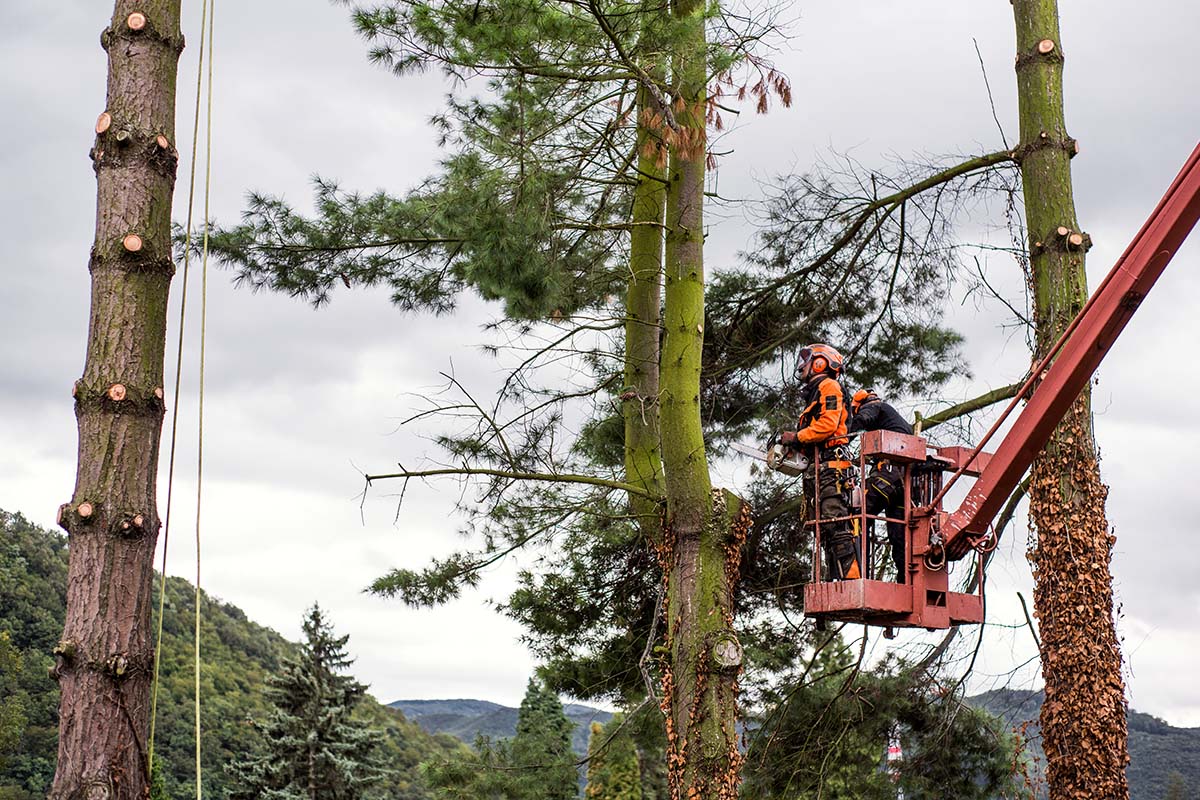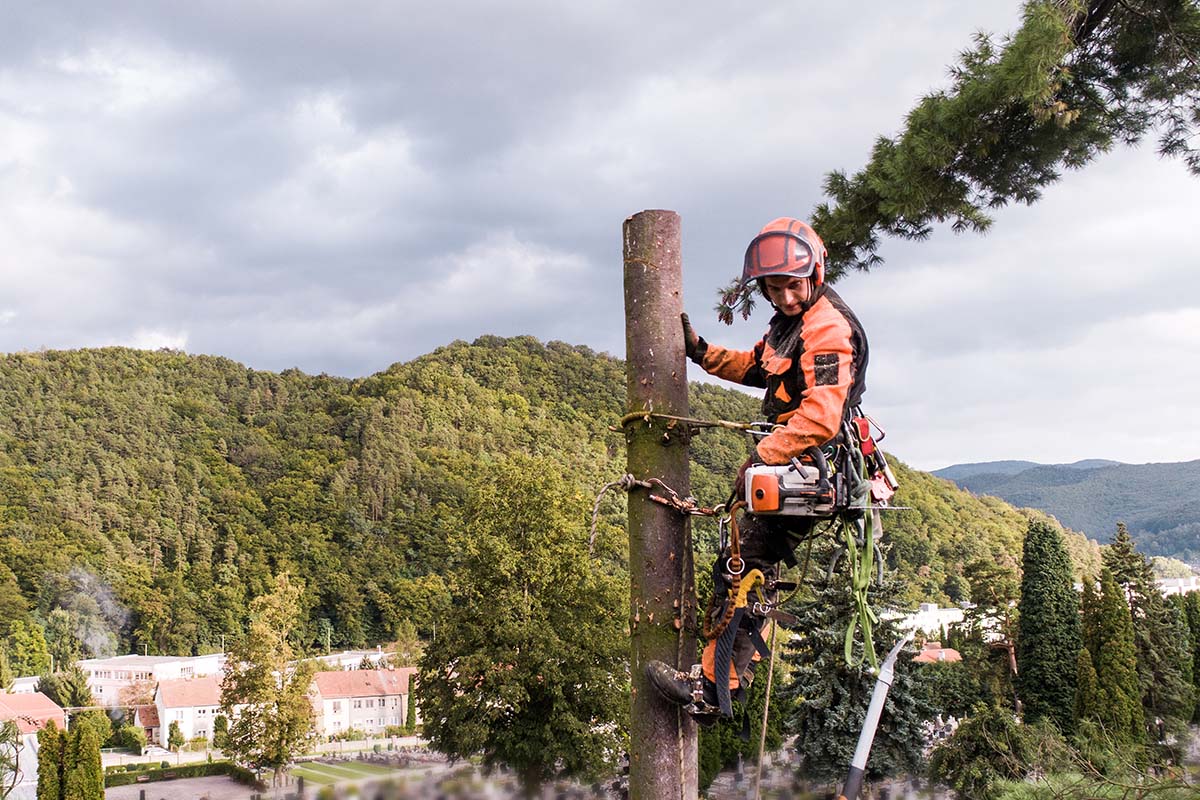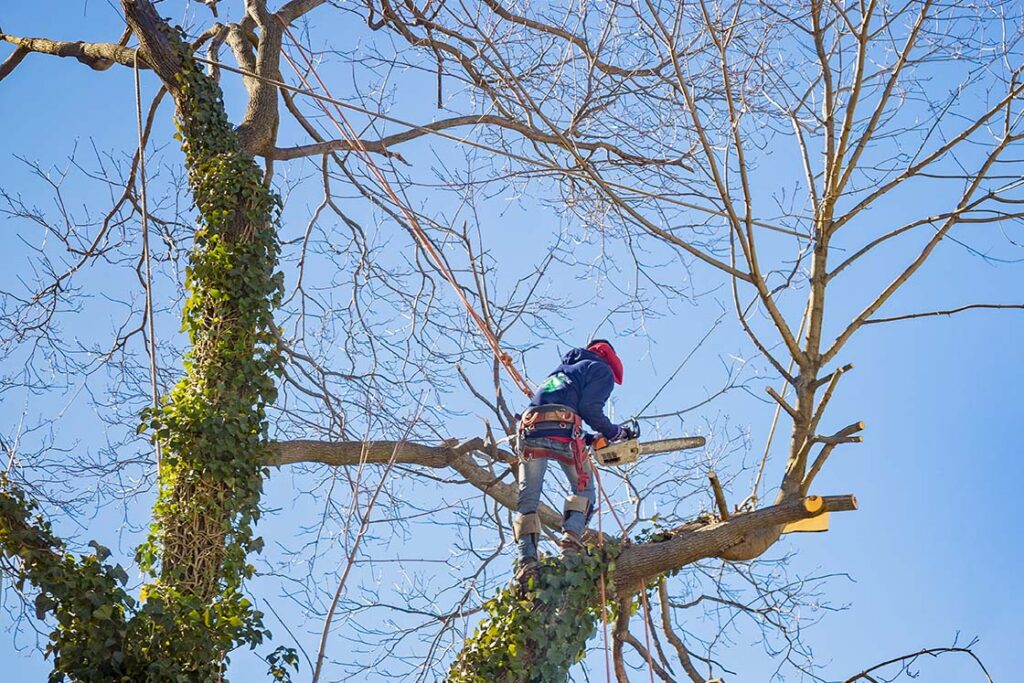
Let’s dive into the various considerations affecting tree removal costs and how to navigate your options wisely.
Key Takeaways
- Tree removal is typically a job best left to professionals, as they have the proper equipment and training to safely cut down and remove the tree.
- The size of the tree is a major factor in the cost of tree removal, with small trees (under 30 feet) costing between $150 and $500, medium-sized trees (30-60 feet) costing between $600 and $1,000, and large trees (60-80 feet) costing $800 to $1,700.
- The type of tree can also affect the cost of removal, with oak trees usually costing $700 to $1,300, palm trees costing $200 to $900, pine trees costing $150 to $2,000, cedar trees costing $500 to $2,000, maple trees costing $1,100 to $2,000, ash trees costing $800 to $2,000, and poplar trees costing $1,500 to $2,000.
- The health or condition of the tree can also impact the price, with diseased or fallen trees generally costing less to remove than living trees.
- Emergency tree removal is generally more expensive than scheduled removal, with prices ranging from a few hundred dollars to several thousand dollars.
- Additional services, such as debris removal, stump grinding or removal, and tree transplanting, can also affect the total cost of tree removal.
- In most cases, it’s not recommended for homeowners to try to remove trees themselves, especially if the tree is taller than 30 feet or within 10 feet of power lines.
- When considering tree removal, be sure to verify the credentials and insurance of any contractors you hire and get multiple quotes to compare prices.
How much does it cost to cut down a tree?
The average cost to remove a tree ranges from $150 to $2,000, with most tree removal services charging around $700 to $750. The price of tree removal depends on the size of the tree, with larger trees typically costing more to remove than smaller ones. It’s important to note that tree removal prices can vary greatly depending on other factors, such as the tree’s location, condition, and the services included in the removal process.
The size of the tree is one of the main factors that determines the cost of removal, with larger trees generally costing more to remove than smaller ones.
While it may be tempting to hire a tree removal service that offers a low price, it’s essential to ensure that you’re working with a certified arborist who is insured for tree removal.
This will ensure that the job is done safely and professionally, without any unforeseen complications or long-term consequences. Remember, arborists must renew their licenses regularly, so they are constantly updated on the latest best practices for tree removal.
Factors That Determine the Cost of Tree Tremoval

- The size of the tree
- The location of the tree
- The type of tree
- The degree of difficulty in removing the tree
- The distance the tree removal company has to travel to reach the tree
- The equipment and manpower required for the job
- The disposal or recycling of the tree debris
- Any additional services, such as stump grinding or landscaping restoration.
Tree removal costs depend on a variety of factors, including the size of the tree, the location of the tree, the type of tree, the degree of difficulty in the removal of the tree, the distance the tree service company has to travel to reach the tree, the equipment and manpower required for the job, and any additional services, such as stump grinding or landscaping restoration.
Size of the Tree
The size of the tree is one of the main factors that determines the cost of tree removal. Trees under 30 feet in height are considered small and generally cost between $150 and $500 to trim. Medium-sized trees, such as maples or elms, which are 30-60 feet tall, typically cost between $600 and $1,000 to trim. Large trees, such as mature oaks that are 60-80 feet tall, usually cost around $800 to $1,700 to trim. Trees taller than 80 feet will cost about $1,500 to $3,000 to trim.
Location of the Tree
The location of the tree can also impact the cost of tree removal. For example, trees that are difficult to access or are located in a tight space may require additional equipment and manpower, resulting in higher costs. On the other hand, trees that are easily accessible may have lower the removal costs.
Type of Tree
The type of tree can also affect the cost of tree removal. Some types of trees, such as pine and cedar, may have needles or leaves that are more difficult to remove, which can increase the cost of removal. Similarly, trees with dense foliage or large branches may be more challenging to trim, resulting in higher costs.
Degree of Difficulty
The degree of difficulty in removing a tree is another factor that can impact the cost. Trees that are in close proximity to buildings, power lines, or other structures may require special equipment or techniques to safely trim them, which can increase the cost. Similarly, trees that have multiple trunks or are particularly tall and wide may be more challenging to trim, resulting in higher costs.
Distance to Travel
The distance the tree removal company has to travel to reach the tree can also affect the cost. If the tree is located far from the company’s base of operations, they may charge additional fees to cover transportation costs.
Equipment and Manpower
The equipment and manpower required for the tree removal or trimming job can also impact the cost. For example, if the tree is large and requires specialized equipment or a large team to trim, the cost will be higher. On the other hand, smaller trees that can be trimmed with basic tools and a smaller team may have lower costs.
Additional Services
Some tree service companies may offer additional services, such as stump grinding or landscaping restoration, which can impact the overall cost of the job. Be sure to discuss any additional services you may be interested in with the tree removal company to get a clear idea of the total cost.
Emergency Tree Removal

In some cases, a tree may need to be removed as soon as possible due to damage, decay, or other emergency situations. In these cases, tree removal companies may charge additional fees for emergency services.
The cost of emergency tree removal may vary depending on the situation and the contractor, but it can easily go up to $5,000 or more.
It’s important to note that while contractors should never engage in price gouging, you may find tree removal prices increasing in areas affected by natural disasters, such as hurricanes or wildfires, due to high demand and limited resources.
Permits and Regulations
Depending on where you live, you may need to obtain a permit or follow certain regulations before trimming a tree on your property. These permits and regulations can vary by city, county, or state, and may include requirements for tree species, tree size, and tree location. Some jurisdictions may require a professional arborist to assess the tree and provide a report before a permit can be issued.
It’s important to check with your local government to determine if you need a permit or need to follow any specific regulations before removing a tree. Some tree companies may offer assistance with obtaining permits or provide guidance on local regulations, so be sure to ask about these services when getting quotes.
Hiring a Professional Tree Removal Service
When hiring a tree removal service, it’s important to do your research and choose a reputable, professional company. Look for credentials such as certification from the International Society of Arboriculture (ISA) and membership in professional organizations like the Tree Care Industry Association (TCIA). Make sure to also ask for references and see examples of the company’s work before making a decision.
In addition to verifying credentials and insurance, it’s also important to discuss the scope of the tree trimming job with the company to ensure that you have a clear understanding of what is included in the price. Make sure to ask about any additional services or fees that may be charged and get everything in writing in a contract before beginning the work.
By following these guidelines, you can choose a reliable and professional tree removal service that will ensure the job is done correctly and maintain the health and appearance of your trees.
Tree removal companies often offer additional services beyond just removing the tree itself. These services can be particularly useful when you are completing a larger landscaping project and want to save money by hiring a company for a comprehensive project rather than breaking it up into multiple jobs.
One of the additional services that tree removal companies may offer is debris removal. While the cost of tree removal typically includes removing and disposing of the trunk and large branches, you may be left with a lot of additional debris that you don’t want to dispose of yourself.
Tree removal companies can offer different options for disposing of this debris for an additional fee. These options may include hauling away the debris for an additional $50 to $100, using a wood chipper to turn the debris into mulch for your next landscaping project (which typically costs $75 to $125 per hour), or splitting the tree and larger branches into fire logs for about $75 to $100 per tree.
Stump Grinding and Stump Removal costs
Stump grinding or removal is another service that tree removal companies may offer. Removing the stump and its roots typically costs between $150 and $500, while stump grinding, which involves using a hydraulic machine to mulch the stump and some of the roots, is typically a little cheaper at $100 to $400.
You can also try removing the stump yourself by renting a stump grinder from a hardware store, although these machines are typically intended for small-diameter stumps. Other, less common methods of stump removal include burning, which costs about $250 per stump, and a chemical treatment, which costs about $100. Learn more on the different ways to kill a tree stump here.
Tree Transplanting
If you like a tree in your yard but want to move it to a different location on your property, you may want to consider tree transplanting. This service can be expensive, with the cost of transplanting small trees ranging from $300 to $800, and the cost of transplanting medium- and large-sized trees potentially reaching tens of thousands of dollars.
It’s important to note that not all tree removal companies are equipped to perform this service, as it requires different equipment than simple cutting.
5 Tips on How To Save Money for Tree Removal
- Choose the right time of year: Removing a tree when it’s dormant (in late winter or early spring) can be cheaper than removing it in the growing season because there are fewer leaves on the tree, making it easier to handle. We’ve written an entire guide on when is the best time to cut a tree.
- Remove smaller trees: As mentioned in the article, small trees (under 30 feet) generally cost less to remove than larger trees. Consider removing smaller trees on your property first to save money.
- Consider tree transplanting: If you like a tree in your yard but want to move it to a different location on your property, tree transplanting may be a cheaper option than removal. Small trees are generally the easiest and cheapest to transplant.
- Get multiple quotes: It’s always a good idea to get multiple quotes from different tree removal contractors to compare prices and ensure that you’re getting the best deal.
- Consider removing the tree yourself: If you’re comfortable using a chainsaw and the tree is in an open area, you may be able to remove it yourself with the proper safety equipment. Just be sure to check whether you need a permit and take necessary precautions to avoid injury or damage to your property.
In conclusion
It’s usually best to leave tree removal to the professionals, as they have the proper equipment and training to safely cut down and remove the tree. However, if you feel comfortable using a chainsaw and the tree is in an open area, you may be able to remove it yourself with the proper safety equipment.
When considering this option, keep in mind that you should always wear goggles, gloves, sturdy work boots, a hard hat, and hearing protection when removing a tree. You should also check if you need a permit to remove the tree, and be aware that you will be liable for any injuries or property damage that may occur.
Additionally, you should consult with an arborist before attempting to remove a tree, as they can provide important information about the tree’s health and whether the project may be more complicated than you expect.
Finally, it’s usually best to remove a tree during the late winter or early spring, when tree growth is dormant and there are fewer leaves on the tree. In general, it’s not recommended to try to remove a tree larger than 10 feet without professional training, as the larger the tree, the bigger the risk.
If you’re looking for tree removal, we can help. At Burbank Tree Pros, we provide the following services:
If you have a palm tree that you’d like to prune yourself, check out our detailed guide on how to safely prune palm trees.
If you’re interested in learning more about trees, check out our article on the most common tree types in Burbank.

